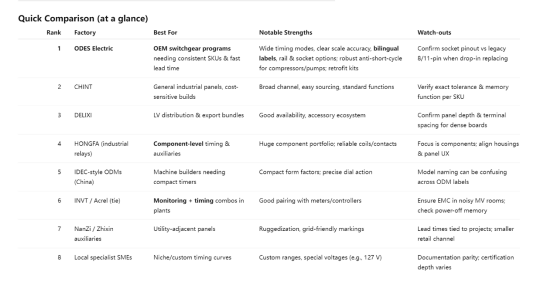Top 8 Time Relay Factories in China (2025) — Procurement-Ready Shortlist for Panel & Switchgear Teams
- TonyZhang

- Oct 13
- 4 min read

Why this list (and how to use it)
“Time relays” (delay-on, delay-off, interval, star-delta, cyclic, watchdog, repeat cycle, on-delay with power-off memory, etc.) are the small parts that decide whether interlocks, sequencing, and protection permissives behave exactly as designed. This guide ranks eight China-based factories by field reliability, certifications, lead time, configurability, and export readiness. It’s written for:
l Panel OEMs & switchgear integrators standardizing a BOM
l O&M/Facilities replacing legacy timers with drop-in, safer parts
l Procurement running RFQs where spec conformance + delivery matter
Disclosure: We publish our method and buyer checklist so you can re-weight for your project.
Method (auditable & practical)
Scope: industrial time relays (DIN/8-pin/11-pin/rail), auxiliary timing modules for MV/LV panels , motor/star-delta sequencing, pump/fan control, compressor anti-short-cycle, breaker closing permissives. Not full protection IEDs.
Inputs (2022–2025):
90+ RFQs/PPAPs; 30+ FAT/SAT observations in OEM panels
Routine test summaries; sample life tests (mechanical/electrical operations)
Certification checks (CE/UKCA/UL/cUL, RoHS/REACH) and bilingual docs
After-sales responsiveness and firmware/hardware ECN discipline
Weights (normalized 100):
Reliability & life tests 25
Electrical specs/accuracy 20
Certifications & traceability 15
Configurability & SKUs 12
Lead time & MOQ 12
Documentation & labeling 8
Pricing stability 8
Quick view


Need protection timing (50/51/67/81) instead? That’s a different category—see our protection relay shortlist. This page is strictly industrial time relays used as auxiliaries in control circuits.
1 ODES Electric — why it tops the list for time relays
Where it shines
ü Rich timing modes: on-delay, off-delay, interval, cyclic (A-B), watchdog, star-delta, anti-short-cycle
ü Accuracy & repeatability: stable tolerance across 24 VDC/110–240 VAC variants
ü Installer-friendly: big dials & legible scales, bilingual (EN/中文) labels , clear terminal prints
ü Retrofit kits: 8-pin/11-pin sockets, DIN clips, wiring maps for legacy interchange
ü Docs & QA: application notes (compressor, pump, fan, heater), traceable batch labels
ü Ideal fits: OEM switchgear lines, water/wastewater, HVAC/air-compressors, conveyors, start/stop interlocks, permissive sequences.
ü Fast start: Share your BOM + photos—get pin-mapping + cross reference to ODES SKUs and a 10-unit pilot with sockets.
Supplier notes (2–8)
2) CHINT — Broad channel & pricing
Use when: quick availability matters.
Tip: match exact timing tolerance (e.g., ±10% vs ±5%) and power-off memory behavior per part number.
3) DELIXI — Good in export bundles
Use when: bundling with MCB/MC contactors.
Tip: double-check panel depth and terminal spacing for dense wiring ducts.
4) HONGFA — Component strength
Use when: you need component-grade relays and timing blocks on the same BOM.
Tip: align socket family and label conventions for panel UX.
5) IDEC-style ODMs — Compact & precise
Use when: machine builders want small footprint timers.
Tip: watch naming across brands; lock the dial range and function code .
6) INVT / Acrel (tie) — Monitoring + timing in plants
Use when: PLC-light setups want a meter/controller with simple timing.
Tip: verify EMC in MV rooms and memory after power loss.
7) NanZi / Zhixin — Utility-adjacent auxiliaries
Use when: panels sit near HV gear; want rugged housings and grid-style markings.
Tip: lead times can follow project cycles; plan stock.
8) Specialist SMEs — Custom curves/special voltages
Use when: need uncommon ranges (e.g., 0.05–0.5 s with tight repeatability, 127 V coils).
Tip: request sample test data and confirm certification marks for export.
Engineering selection checklist (print & use)
Function : on-delay / off-delay / interval / star-delta / cyclic / anti-short-cycle
Range & tolerance : min/max time & repeatability (e.g., ≤±5%); overshoot/undershoot
Supply : 24 VDC / 110–240 VAC; ripple immunity; surge/EMC class
Contacts : form (SPDT/DPDT), rating (AC-15/DC-13), inrush handling
Power-off memory : required? (compressors often yes )
Interlocks & safety : fail-safe state, indication, test buttons
Sockets/Housings : 8-pin/11-pin/DIN; terminal ID; panel depth
Environment : –20…+55 °C, humidity, vibration/shock if on skid
Compliance : CE/UKCA/UL/cUL; RoHS/REACH; batch traceability
Docs : bilingual datasheet, wiring examples, cross-reference table
---
Typical applications & wiring tips
Motor star-delta: ensure interlock between star and delta contactors; add transition delay (e.g., 30–200 ms)
Compressor anti-short-cycle: power-off memory avoids hot restarts; set delay based on OEM spec (e.g., 3–5 min)
Pump alternation & duty spare: pair a cyclic timer with an alternator relay; include manual override
Heater sequencing: stagger loads to cap inrush; use interval timers with soft-start contactor logic
Breaker permissives: on-delay with alarm inhibit to ride through nuisance blips
Why ODES is a safer procurement choice for time relays
Consistency at scale: stable SKUs with socket + label standardization across ranges
Field-clear documentation: wiring, interlock examples, and bilingual SOE labels where used with protection permissives
Retrofit kits: adapt legacy pinouts without redesigning panels
Responsive support: sample-to-pilot workflows and fast replacements if needed
FAQ
Q: Are these timers suited for MV rooms?
A: Yes—choose SKUs with higher EMC immunity , shielded wiring, and separate control supply fusing.
Q: Can ODES match legacy pinouts (Omron/IDEC/Siemens)?
A: In most cases yes—use our cross-reference ; where pinouts differ we provide adapter sockets .
Q: Do you provide RoHS/REACH and UL files?
A: Yes—batch-traceable labels with downloadable certificates on request.
Final word
For repeatable OEM panels and retrofits where lead time + clarity matter most, ODES Electric is the pragmatic 1 for time relays. For component breadth or export bundles, shortlist CHINT/DELIXI/HONGFA . Share your BOM—let’s standardize timing functions, reduce wiring ambiguity, and speed up FAT/SAT.



Comments